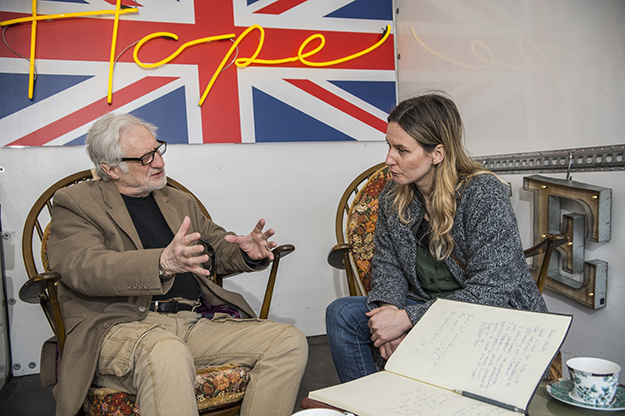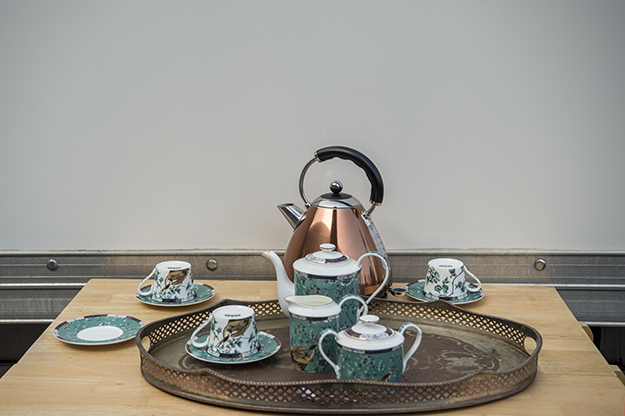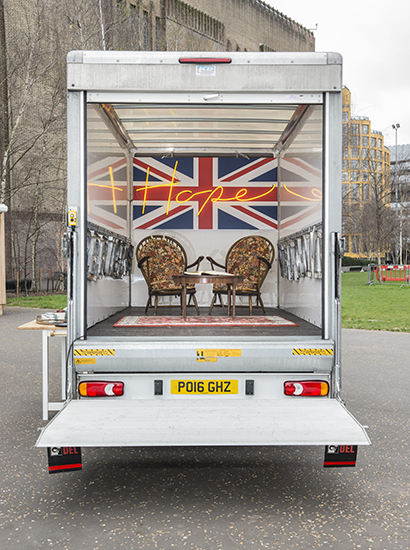Alketa Xhafa Mripa is sitting in the back of an open truck parked in front of one of the most iconic buildings in London. Cup of tea in hand, she converses warmly with one of the many visitors to her most recent installation, “Refugees Welcome.” It is part of a wider series titled “Who Are We?” that reflects on topics such as identity, belonging and migration.
Xhafa Mripa’s installation stands out as it isn’t situated in a corner of a room, but instead sits proudly, albeit in the back of a parked vehicle, outside the entrance of the museum. Endless curious faces peer into the back of the truck, and once they see the bright lettering of ‘Refugees Welcome’ and ‘Hope,’ alongside the beautiful china that adorns the vintage table at the centre of it all, looks of confusion soon turn into smiles.
The artist has created a space that invites people to sit with her and share their thoughts, opinions and personal stories on the topic of refugees. The atmosphere is warm and welcoming, which is precisely what Xhafa Mripa wishes to depict. It’s this warmth that she associates with Britain when recalling her arrival in the U.K. as an art student in 1997. Soon after, she was no longer able to return to her home country, Kosovo, as war was erupting and people were desperately trying to flee.

In Alketa Xhafa Mripa’s latest installation, “Refugees Welcome,” she created a space in the back of a van that invites people to sit and share their thoughts and stories on refugees. Photo: Blerim Racaj.
The topic of refugees remains a hefty and highly contentious issue to address, but Xhafa Mripa is no stranger to using her art in order to raise awareness of important social issues. It is this social conscience, this activism that garnered Xhafa Mripa support from Kosovo’s former president, Atifete Jahjaga, who helped bring to Kosovo the installation for which she is best known: “Thinking of You.”
In 2015, Xhafa Mripa used Prishtina’s football stadium as her canvas, adorning it with donated skirts and dresses in remembrance of the wartime sexual violence that thousands endured. It was an installation praised by many; unprecedented was her work in challenging such a taboo topic on such a grand scale. She took the expression ‘airing out dirty laundry’ literally, and forced the country, as well as the world, to face an injustice for which many were ashamed and felt ostracised.
K2.0 sat down with the artist and discussed the drive behind her activism, how it shapes her art and how so much of her identity and experiences play a role in the work she produces.
K2.0: Having once been a refugee yourself, perhaps the first question to ask you isn’t ‘What inspired you to create this installation?’ Rather, what has been the inspiration behind your approach?
Alketa Xhafa Mripa: Coming here 20 years ago as an art student, within two years I couldn’t go back to my country because the war had begun. I used to work with the Red Cross so I would see the solidarity of the British people, they were so welcoming and that’s how I associated Britain — with them opening their hearts and their homes to people in need. So I began questioning what happened to the welcome that I experienced. The dynamic has changed drastically over the past few years.

Xhafa Mripa says that when she arrived in the U.K. from Kosovo in 1997 people opened their hearts and homes, whereas now the atmosphere is changing. Photo: Blerim Racaj.
The installation was first debuted at the British Museum, and now here we are sitting in the back of an open truck — what’s the meaning and inspiration behind that?
Two years ago I was on holiday in France, and as I was passing Calais to come to the U.K. I saw refugees on the side of the road desperately trying to get onto a truck. I could see the freedom that the truck symbolized for those people, because it came with the hope and opportunity to get to another country that can provide the safety they don’t have. But on the other hand, the truck has the element of being a tomb, because so many have died this way. I thought ‘how can I capture this, what I’m seeing — visually?’ So that’s how it came about, that contrast, and an invitation for people to come in and share.

Xhafa Mripa believes that, for refugees, a truck can symbolize both freedom and a tomb. Photo: Blerim Racaj.
Each piece of work you’ve created has taken you on a journey in one way or another. Before embarking on this one, what were your hopes and aims with this installation?
I remember being a little girl, 5 or 6 years old, watching TV and seeing schools in Kosovo being shut down and students being poisoned, I used to say to myself, ‘My God, how can the rest of the world just stand by and watch while this is happening?’ So for me, those issues like sexual violence, human rights etc. were deep rooted in me, in the way I was brought up and the way I was surrounded politically. And now I see it happening around me, people in desperate situations, and that voice within me is coming out, this need to be the voice for the voiceless. It’s just doing my part as a human being, as well as an artist, capturing all those things visually.
This isn’t the first time you’ve created a piece of work that initiates and inspires dialogue about a contested issue…
To this day Kosovo is still a very patriarchal society, but growing up in my family in my surroundings I didn’t see that — it wasn’t how I was raised. It was only when I began growing up that I could see the disparities in society, and where we as women stand. So as a result, I’ve always tried to bring the beauty of women to the forefront. Not the aesthetic beauty, but the beauty in our strength, and in a way that is what I wanted to do with “Thinking of You.” But even before then, I’ve tried to confront issues that many avoid — my 2015 exhibition here in London involved pieces about me breastfeeding my children and being proud of it, and one involved washing my father. All these taboos that aren’t spoken about, which is precisely why I called the exhibition “You Just Don’t Talk About It.”

